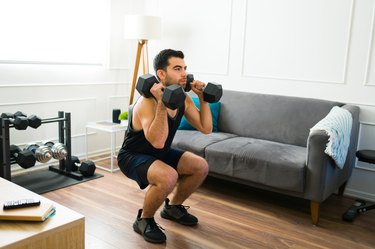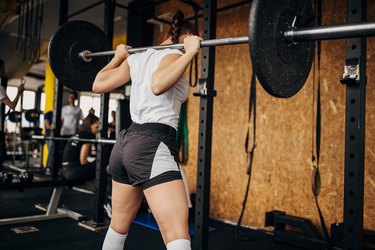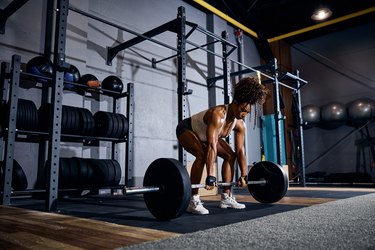
If you think of squat variations as different types of salsa, the air squat might be your average mild option — and the squat thruster, aka dumbbell thruster, is the spiciest of the mix. This full-body exercise takes your squat dreams to new heights by incorporating an overhead press.
That means the squat thruster not only targets your lower half but also works your upper body. Here's everything you need to know about squat thrusters and how to do them with effective form.
Video of the Day
- What is a squat thruster? It's a compound exercise that involves holding weight (often dumbbells, a barbell or kettlebells) by your shoulders and then squatting down and pressing the weight overhead in one fluid motion.
- What muscles does the squat thruster work? The squat thruster primarily targets your quads, glutes and shoulders, says Patrick Bryan, CSCS, a certified strength and conditioning specialist and regional fitness manager at Orangetheory Fitness. But it also activates your core and works your triceps, too, when doing the overhead press, says Zach Ray, DPT, SCS, a physical therapist and founder of Live Athletics.
- Who can do squat thrusters? Nearly anyone can do this exercise, however, those who have pain squatting or pressing overhead should avoid it. "Usually, the thruster's limiting factor is the weight selection. Because of this, most people can do this exercise if they choose the appropriate weights," Bryan says.
What's the Difference Between a Squat Thruster and a Squat Thrust?
Whether you're using kettlebells, a barbell, a medicine ball or a weight plate, the squat thruster is a compound movement that combines a weighted squat with an overhead press. On the other hand, the squat thrust is a burpee variation, also known as a sprawl, where you start in a quarter squat and then drop down to place your hands on the floor in a push-up position. Next, you walk or hop your feet forward to the outsides of your hands and jump up explosively. Learn how to do more burpee variations here.
How to Do the Squat Thruster With Proper Form
- Stand tall and hold a dumbbell or kettlebell in each hand. Rack the weights up by your shoulders. Your elbows should be facing the wall in front of you.
- Keeping your feet flat and rooted to the floor, brace your core and hinge your hips back and down, bending your knees until your thighs are parallel to the ground (or as low as you can comfortably go with good form). Try to keep your torso upright as much as possible with your elbows high and your gaze forward.
- From the bottom of your squat, push your feet into the ground to stand back up explosively.
- Once your ankles, knees and hips are extended, punch the weights up using power from your legs, rotating your palms forward. You want to keep your rib cage down and arms fully extended at the top with your biceps by your ears.
- Rotate your palms back to facing each other and lower the weights back to your shoulders as you squat back down.
Tip
Try to keep your upper body as vertical as possible. If your upper body leans too far forward and/or your elbows drop, you can lose your balance, Bryan says. At the bottom of your squat, you are thinking about exploding vertically through your legs.
Once you have rapidly extended your ankles, knees and hips, you begin to punch the weights vertically. Ideally, your rib cage should be down and your arms fully extended at the top of your thruster, Bryan adds. As your lower the weights back to your shoulders, you want to begin squatting to help your lower body absorb the force, Ray says.
Squat Thruster Tutorial
5 Squat Thruster Benefits
1. It Targets Your Upper and Lower Body
Because the squat thruster is a combination of a weighted squat and overhead press, it is very effective in training your upper- and lower-body muscles, including your quads, glutes, core, shoulders, upper chest muscles and triceps.
"You're using the lower half of your body to generate some of the force on the upper body, which is really good for people to understand how to do," Ray says.
That's because you're learning how to incorporate your full body in one fluid motion:
- Core: Throughout the exercise, you'll brace your core to help stabilize your upper body and maintain your balance.
- Lower Body: During the squat, you'll activate your quads and glutes, as well as your hamstrings, Ray says.
- Upper Body: As you press the weight overhead from the bottom of the squat, your upper chest and shoulders will assist.
- Triceps: You'll also engage your triceps because you have to lock out your elbows at the top of the movement.
2. It Makes Overhead Pressing More Accessible
Overhead pressing can be difficult for a lot of people because it requires good shoulder mobility and rotator cuff strength. The squat thruster enables you to recruit the muscles in your legs to generate power so that you can press the weight overhead instead of strictly using your upper body, Ray says. It also helps you learn how to stabilize weight overhead using your core.
"In this exercise, the weight will jump off your shoulders after the hips extend because we are driving through the ground aggressively with our lower bodies. For a fraction of a second, this allows the weight to move vertically without any tension on the shoulders at all," Bryan says.
"It takes the very bottom of a strict press out of the equation. Our shoulders do not start pressing until the dumbbells [or kettlebells, weight plate or barbell] stop moving vertically from our lower body's efforts."
3. It's Functional for Everyday Tasks
If done correctly, the squat thruster employs three different movement patterns: the hip hinge, squat and press, which are all essential for performing daily tasks, like lifting something heavy off the ground and placing the object on a top shelf, Ray says. (FYI, you basically squat every day when you sit down from standing.) These three movement patterns target your quads, glutes, shoulders and core — important muscle groups we use regularly.
"Whether we are reaching overhead for a bowl in the cabinet or picking up a laundry basket around the house, these are muscles that we use in our everyday lives. The longer we keep these muscles strong, the longer we can live without assistance in doing daily activities," Bryan says.
4. It Improves Your Vertical Power
The squat thruster is all about using explosive power from your legs to drive weight overhead. Everyone can benefit from learning how to generate force from the ground up. It's an essential skill not only for sports performance but also for daily life.
"When doing a thruster, not only are you working most of the muscles in your body, but you're also teaching yourself to be explosive. Thrusters are a great way to activate our fast-twitch muscle fibers that sometimes are neglected by the general population. These muscle fibers are the ones that help us generate a ton of power in a short amount of time," Bryan says.
5. Squat Thrusters Get Your Heart Rate Up
Compound exercises with explosive movements, like the squat thruster, are going to increase your heart rate because you want to move weight down and up as fast as possible, Ray says.
"The great thing about thrusters is that they can improve your overall strength with low reps and long rests, but they can also improve your cardiovascular health with higher reps and shorter rests," Bryan says. "It only takes a few reps of thrusters to send your heart rate sky-high because you're using so many muscles at an explosive tempo. You get a high return on your overall physical fitness in a low amount of time with the thruster."
How to Fix Common Squat Thruster Form Mistakes
1. You're Arching Your Lower Back
This often means that you're not engaging your core while squatting. It can also be a sign that you're lifting weights that are too heavy too soon. Use your normal squat weight, or choose slightly lighter weights to start and gradually add load as you get stronger.
You want to make sure that you're bracing your core as you descend into the squat and drive the weights upward explosively. Bracing your core helps keep your upper body stable while also taking pressure off your lower back, Ray says.
2. You're Not Squatting Low Enough
Many people may rush through their reps and not squat low enough to reap the full glute and quad benefits of this move. Ideally, you want to aim for a squat depth where your thighs are at least parallel to the ground.
According to a June 2019 article in the European Journal of Applied Physiology, full squat training activates the gluteus maximus (largest glute muscle) and adductor muscles (inner thigh muscles) significantly more than half squat training.
If you're able to get lower than parallel, that's even better, but you should work within your range of motion and squat as deep as you can while maintaining safe and effective form, Ray says. Just remember to keep your feet anchored to the ground at all times and avoid lifting your toes and heels.
3. You're Allowing Your Elbows to Drop and Upper Body to Fall Forward
If this is happening, it usually means that your ankle and front-rack mobility could use some work, Bryan says.
"Improving ankle mobility will help the knees travel forward naturally, causing the torso to stay more vertical. Improving front-rack mobility, specifically in the lats, can help keep your elbows high during the exercise," he says.
4. You're Not Getting Explosive Enough With Your Lower Body
The squat thruster is an explosive exercise where you're using power from your legs to punch the weights overhead. To increase your explosiveness, Bryan suggests envisioning jumping from the bottom of the squat. Generating force from your lower body will help you "jump" the weights off your shoulders.
5. You're Rushing Into the Overhead Press
Again, you want the weight to jump off your shoulders so that the transition from the squat to the press is one seamless move. Try doing a few explosive reps without incorporating your upper body. This will help you get a better sense of how it feels for the weights to jump off your shoulders, Bryan says.
3 Squat Thruster Variations
1. Box Squat Dumbbell Thruster
If you would like to improve your squat depth and ensure you're activating your glutes, Ray recommends sitting on an exercise box or bench and starting the exercise from the bottom of the squat. This modification allows you to add load while ensuring that you're hinging your hips back and squatting deep enough to reap the glute-building benefits.
- Sit on a plyo box or low bench and hold two dumbbells in the front-rack position by your shoulders. Your elbows should be facing the wall in front of you.
- Keeping your feet flat on the floor, brace your core and push your feet into the ground to stand back up explosively.
- After your ankles, knees and hips are extended, punch the weights overhead using power from your legs, rotating your palms so that they face forward. You want to keep your rib cage down and arms fully extended at the top with your biceps by your ears.
- Lower the weights back to your shoulders as you squat back down to the box or bench.
2. Push Press
A regression of the thruster, the push press involves squatting down only a few inches by slightly bending your knees. "You could think of this as a dip of the hips rather than a squat," Bryan says.
- Stand tall and rack the dumbbells or kettlebells up by your shoulders. Your elbows should be facing the wall in front of you.
- Keeping your feet flat and rooted to the floor, brace your core and bend your knees slightly into a quarter squat. Think of taking a small dip in your hips. Keep your elbows high and your gaze forward.
- Pushing your feet into the ground, use power from your legs to stand back up explosively.
- Once your ankles, knees and hips are extended, punch the weights overhead. You want to keep your rib cage down and arms fully extended at the top with your biceps by your ears.
- Lower the weights back to your shoulders to return to the starting position.
3. Single-Arm Squat Thruster
Using one weight will challenge your balance and core strength more to help you stabilize, which makes this variation a progression of the squat thruster. "It will take a lot of stability to keep your shoulders level and avoid leaning toward one direction," Bryan says.
- Stand tall and rack a heavy dumbbell or kettlebell on one shoulder. Your elbow should be facing the wall in front of you. You can extend your opposite arm straight to the side and make a fist to help keep your shoulders square.
- Keeping your feet flat and rooted to the floor, brace your core and hinge your hips back and down until your thighs are parallel to the ground (or as low as you can comfortably go with good form). Try to keep your torso upright as much as possible with your elbow high and your gaze forward.
- From the bottom of your squat, push your feet into the ground and use power from your legs to stand back up explosively. Once your ankles, knees and hips are extended, punch the weight overhead.
- Lower the weight back to your shoulders then squat back down.


